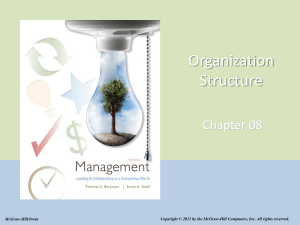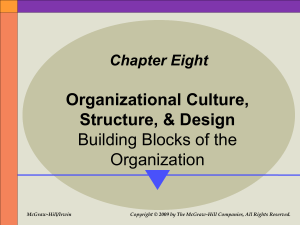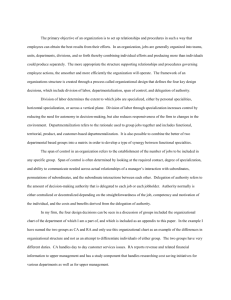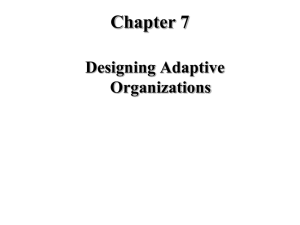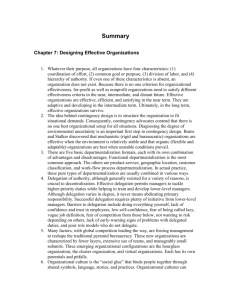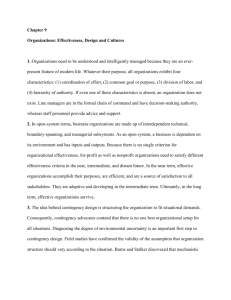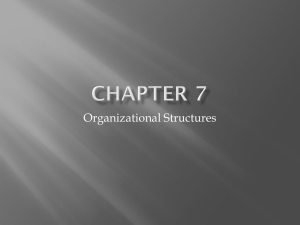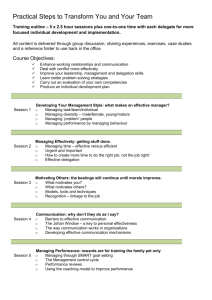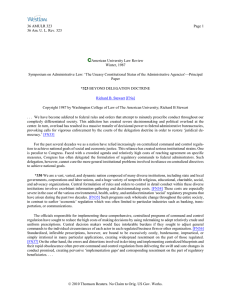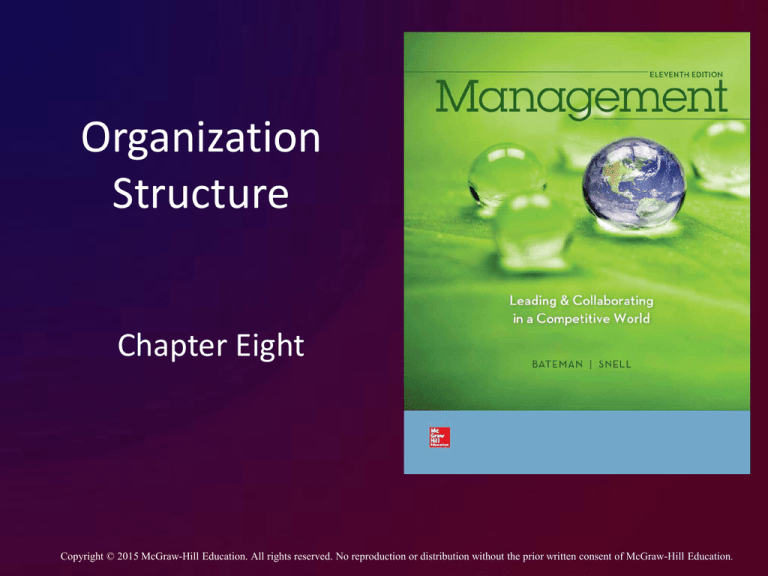
Organization
Structure
Chapter Eight
Copyright © 2015 McGraw-Hill Education. All rights reserved. No reproduction or distribution without the prior written consent of McGraw-Hill Education.
Learning Objectives
LO 1 Explain how differentiation and integration
influence an organization’s structure.
LO 2 Summarize how authority operates.
LO 3 Define the roles of the board of directors and
the chief executive officer.
LO 4 Discuss how span of control affects structure
and managerial effectiveness.
LO 5 Explain how to delegate effectively.
8-2
Learning Objectives (cont.)
LO 6 Distinguish between centralized and
decentralized organizations.
LO 7 Summarize the ways organizations can be
structured.
LO 8 Identify the unique challenges of the matrix
organization.
LO 9 Describe important integrative mechanisms.
8-3
Fundamentals of Organizing
Organization chart
The reporting
structure and
division of labor in an
organization
8-4
Conventional Organization Chart
Figure 8.1
8-5
Fundamentals of Organizing
Differentiation
the organization is
composed of many
different units that
work on different
kinds of tasks, using
different skills and
work methods.
Integration
degree to which
differentiated work
units work together
and coordinate their
efforts
8-6
Differentiation
Division of labor
The assignment of
different tasks to
different people or
groups
Specialization
A process in which
different individuals
and units perform
different tasks
8-7
Integration
Coordination
The procedures that link the various parts of an
organization for the purpose of achieving the
organization’s overall mission
8-8
Authority in Organizations
Authority
The legitimate right
to make decisions
and to tell other
people what to do.
8-9
Authority in Organizations
Board of
Directors
Chief
Executive
Officer
Top
Management
Team
8-10
Hierarchical Levels
Hierarchy
The authority levels of the organizational
pyramid
Corporate governance
The role of a corporation’s executive staff and
board of directors in ensuring that the firm’s
activities meet the goals of the firm’s
stakeholders
8-11
Span of Control
Span of control
The number of subordinates who report directly
to an executive or supervisor
Tall, flat
8-12
Question
What is the assignment of new or additional
responsibilities to a subordinate?
A. Subordination
B. Delegation
C. Designation
D. Allocation
8-13
Delegation
Delegation
The assignment of new or additional
responsibilities to a subordinate
Responsibility, Authority,
and Accountability
8-14
Delegation
Responsibility
The assignment of a task that an employee is
supposed to carry out
Accountability
The expectation that employees will perform a
job, take corrective action when necessary, and
report upward on the status and quality of their
performance
8-15
Advantages of Delegation
Leverages managers’ energy and talent
Allows managers to accomplish more than they
could on their own
Helps develop effective subordinates.
Promotes a sense of being an important,
contributing member of the organization, so
employees tend to feel a stronger commitment,
perform their tasks better, and engage in more
innovation
8-16
Steps in Effective Delegation
Figure 8.2
8-17
Decentralization
Centralized
Decentralized
organization
organization
An organization in
An organization in
which high-level
executives make
most decisions and
pass them down to
lower levels for
implementation
which lower-level
managers make
important decisions
8-18
The Horizontal Structure
Line departments
Units that deal
directly with the
organization’s
primary goods and
services
Staff departments
Units that support
line departments
8-19
The Functional Organization
Functional
organization
Departmentalization
around specialized
activities such as
production,
marketing, and
human resources.
8-20
The Functional Organization
Figure 8.3
8-21
Advantages of Functional
Organizations
1.
2.
3.
4.
5.
6.
Economies of scale can be realized
Monitoring of the environment is more effective
Performance standards better maintained
Greater opportunity for specialized training and skill
development
People have greater opportunity for specialized
training and in-depth skill Development
Decision making and lines of communication are
simple and clearly understood
8-22
The Divisional Organization
Divisional
organization
Departmentalization
that groups units
around products,
customers, or
geographic regions.
8-23
Advantages of the
Product Approach
1. Information needs are managed more easily
2. People have a full-time commitment to a
3.
4.
particular product line
Task responsibilities are clear
People receive broader training
8-24
The Divisional Organization
8-25
The Matrix Organization
Matrix organization
An organization composed of dual reporting
relationships in which some managers report to
two superiors—a functional manager and a
divisional manager
8-26
Matrix Organizational Structure
Figure 8.5
8-27
Advantages of a Matrix Design
Table 8.2
8-28
Disadvantages of a Matrix Design
Table 8.2
8-29
The Network Organization
Network organization
A collection of independent, mostly singlefunction firms that collaborate on a good or
service
8-30
A Network Organization
Figure 8.7
8-31
The Network Organization
Dynamic network
Temporary
arrangements among
partners that can be
assembled and
reassembled to
adapt to the
environment
Broker
A person who
assembles and
coordinates
participants in a
network
8-32
Question
___________ is establishing common routines
and procedures that apply uniformly to
everyone.
A. Coordination by standardization
B. Coordination by plan
C. Coordination by mutual adjustment
D. Coordination by service
8-33
Coordination by Standardization
Standardization
Establishing common
routines and
procedures that
apply uniformly to
everyone.
Formalization
The presence of rules
and regulations
governing how
people in the
organization interact.
8-34
Coordination by Plan
Coordination by plan
Interdependent units are required to meet
deadlines and objectives that contribute to a
common goal
8-35
Coordination by Mutual Adjustment
Coordination by
mutual adjustment
Units interact with
one another to make
accommodations to
achieve flexible
coordination
8-36
Reducing the Need for Information
Slack resources
extra resources on
which organizations
can rely in a pinch so
that if they get
caught off guard,
they can still adjust
Creating selfcontained tasks
changing from a
functional
organization to a
product or project
organization and
giving each unit the
resources it needs to
perform its task
8-37
Increasing Information-Processing
Capability
1. Direct contact among managers who share a problem
2. Liaison roles to handle communication between two
3.
4.
5.
6.
departments
Task forces brought together temporarily to solve a
common problem
Teams, or permanent interdepartmental decisionmaking groups
Product, program, or project managers
Matrix organizations
8-38
Managing High InformationProcessing Demands
Figure 8.8
8-39
Video: New Belgium Brewery
Is New Belgium Brewery a centralized or
decentralized organization?
How does this make them more effective?
8-40

